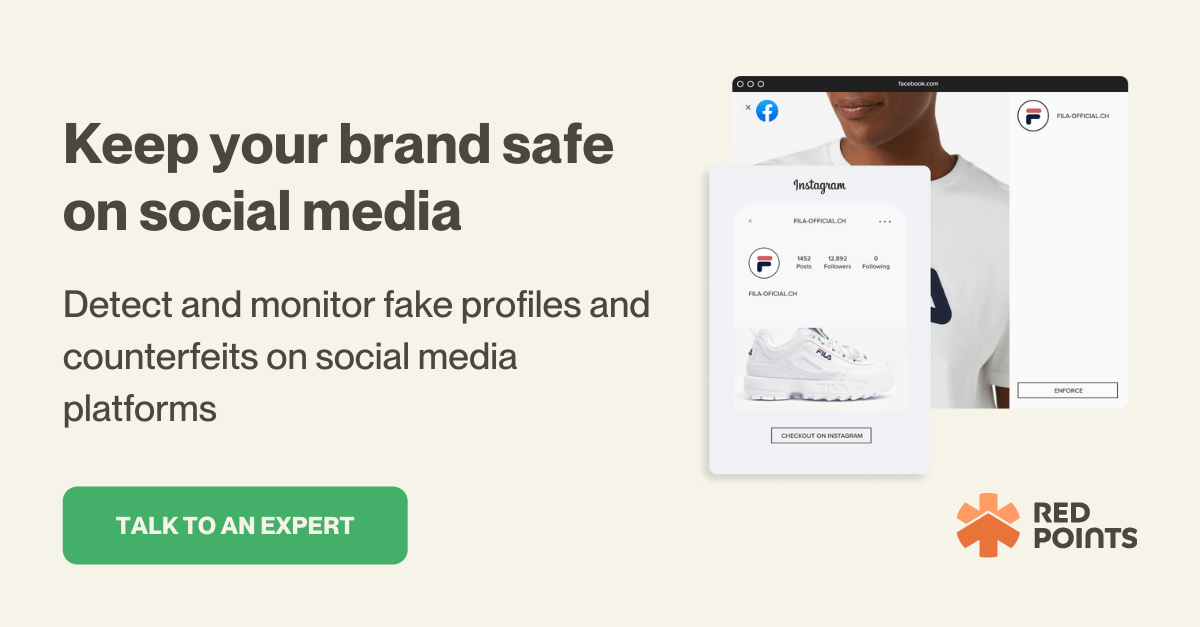
Table of Contents:
Last updated on: June 27, 2022
Even with all the newer social media networks and platforms, Facebook remains one of the largest social media platforms, with close to 3 billion monthly active users.
Meaning for businesses who are looking to have an optimal online presence, Facebook is still a platform worth focusing their efforts on.
Yet, while Facebook is definitely a great platform for building brand awareness, engaging with prospective customers, and promoting products/services, there are still many scammers and cyber criminals lurking on the platform, with the creation of fake profiles and business pages being the most common crimes happening on the platform.
While Facebook has been really serious in cleaning its network from cybercriminals in recent years, unfortunately, it’s still not enough. Facebook still can’t detect and take down all fake pages and profiles on its own, and in many cases, it still relies on manual reporting by users.
Wanting to maintain or improve your business’s online presence on Facebook but afraid these fake profiles will hinder your progress? This guide is for you.
In this post, we will discuss how to report and take down a fake Facebook page and other tips you can use to protect your business’s reputation and improve your customers’ experience.
Let us begin right away.
With billions of active users on Facebook, it’s only obvious that there are also billions, if not tens of billions of pages and profiles on the network. If you are an established or fairly well-known brand, it’s quite likely you’ll have some pages claiming to be your brand in one way or another.
However, the vast majority of these fake or duplicate pages tend to be non-malicious in nature. In fact, there are four potential scenarios of your brand dealing with fake/duplicate pages, but only two of them are malicious in nature.
They are:
1. Impersonating your individual profile
In this case, an external party (a malicious user) creates a Facebook account while duplicating your profile and content, intentionally impersonating yourself. They may use your profile picture and cover photos and create a page with a similar name to yours.
What’s the purpose of the perpetrator here? In many cases, these perpetrators will send friend requests to your legitimate Page’s friends, and followers, typically by making excuses like your original page/profile was hacked, so you needed to create a new one.
This type of attack tends to target users that are not tech-savvy or older users (i.e., senior users) who tend to be less equipped to combat these online scammers.
Once they’ve convinced your followers to follow this new Page, they either scam or phish these followers with various schemes they can monetize.
2. Impersonating your business page
This scenario is quite similar to the first one above but also has significant differences.
Basically, the common technique used by scammers and hackers, in this case, is to create a new Facebook profile with a name and basic information. Once the profile is completed, they can then use the profile to create a new Facebook page, inviting the business’s legitimate clients and prospects.
Typically this fake business page will use the information from the legitimate brand’s Page: confusingly similar page name, URL, images/photos, information, and so on. This way, the Page can confuse prospective followers that can’t tell which of the two pages is the real one.
Then the perpetrator can use the Page to spread scams, phishing schemes, and other types of abuse.
3. Claimed unowned Page
Quite some time ago, Facebook had a feature called “location pages,” allowing users to “check-in” to these pages when they visited a business (i.e., a restaurant), similar to Foursquare, Yelp, and Tripadvisors, among others.
Facebook allowed brands to claim their location pages and fill in the information themselves. However, over the years, Facebook decided to scrap this feature, essentially merging these location pages with brand pages.
Yet, there is still a rare chance you may find a location page of your brand that is claimed by others (often without malicious intent,) and you may want to claim this Page as your own.
4. Abandoned/defunct page
Last but not least, in this type of scenario, there’s a Facebook Page that represents your brand, but it’s not yours and is inactive.
Probably someone tried to create a fake impersonation page but didn’t gain any traction, so they abandoned it. It’s also possible someone in your company (i.e., previous employees) created this Page on behalf of your brand and simply forgot about it.
Nevertheless, this Page is there but doesn’t do any damage to your brand at the moment.
If the Page still has some potential value, then you can try to gain ownership over the Page by contacting the Page’s owner (i.e., by posting directly on the Page or via Facebook Messenger.), and if you don’t get any response, you can file a complaint directly to Facebook (more on this later.)
Or else, if the abandoned Page has no real value in it, then you can simply ignore it or try to claim the Page’s ownership and then delete it.
With the number of cybercriminals all around the world and the massive size of Facebook, preventing thousands, if not millions, of bad actors from creating fake Pages impersonating your brand is obviously very difficult, if not impossible.
With that being said, it’s far more effective to tell your target audience which of these pages is your original one instead. There are ways you can increase your Page’s legitimacy, for example, by linking your website, Instagram account, or YouTube to the Facebook Page. However, the best approach here is to get your Facebook Business Page verified.
Once your Facebook Page has been verified by Facebook, you’ll get either a gray or blue tick next to the Page’s name that can be easily seen by others. This way, prospective followers can easily identify that your Page is the verified, real one.
You’ll get a blue tick if you are a media company or government organization. Or else, if you are a local business or standard for-profit organization, you’ll get a gray tick.
In the past, verifying your Page on Facebook tended to be a very challenging and time-consuming process, but it’s no longer the case at the moment. Yet, you’ll still need to prepare some basic requirements before you can apply for verification:
Once you’re prepared, we can move on to the actual process of getting verified, and you can follow these simple steps:
That’s it, and what’s left is to wait for Facebook’s approval.
One of the key reasons for Facebook’s popularity is its ease of use. However, this can be a double-edged sword since, for the sake of this ease of use, Facebook doesn’t ask users to verify whether they legitimately own a name (including brand name) when they create a Page.
Meaning, that literally anyone can use your brand’s identity and start a Page with your brand’s name and information.
While Facebook may warn brands with established or well-known names when someone tries to create a Page using their name, most businesses (and probably yours) won’t get this luxury.
This is why business owners should be proactive and regularly monitor whether someone is impersonating their business on Facebook. Here are some tips and tricks on how you can do it:
Once you’ve identified the fake Page or profile impersonating your brand, the next step is to report these fake business Pages to Facebook so they can take action.
Fortunately, nowadays, the process of reporting and taking down a Facebook Page or profile is very easy to do, and you can follow these steps:
If you currently don’t have a Facebook account but would like to report someone pretending to be you or your business, you can use this form and follow the on-screen instructions.
Typically when filing your complaint, you are not required to provide any proof or documents. Facebook will use its internal algorithm to verify the disputed Page/profile’s information. However, there are cases when you may be required to provide proof of ownership to ensure you have the right to report this Page as a registered trademark owner.
Facebook may need up to a week to review the complaint and will respond to your request. If the request is rejected, then you may want to consider providing more proof and file another complaint.
If maintaining a positive reputation on Facebook and other social media is important for your brand, then it’s crucial to regularly monitor the presence of fake Pages impersonating your brand, as well as other brand abuse attempts you may get on the platform.
To maintain a positive online reputation, you should definitely consider establishing a comprehensive digital brand protection strategy to protect your brand’s integrity. In the long run, having a digital protection strategy can also help protect your business from potential legal repercussions and losses in money and resources.
Investing in a brand protection software like Red Points can ensure potential infringements surrounding your Facebook Page and overall social media presence, and you can make sure your brand reputation is protected around the clock.
